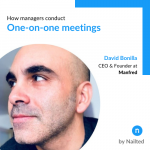
Developing a feedback culture is key for any company that wants to succeed but, do you know how to do it effectively?
Marta Eyre, HR Expert at EXCEM, shows us how to improve our methods of giving and receiving employee feedback in order to maintain a healthy feedback culture that leads to good company culture.
Episode transcript
LAURA HERNÁNDEZ: Hi, everybody. I’m Laura Hernandez, your host. Welcome to another episode of company culture matters by Nailted.
LAURA HERNÁNDEZ: In this episode, we will learn how to give and receive feedback effectively with Marta Eyre, an expert in human resources at EXCEM.
MARTA EYRE: Having a feedback culture helps not only employees improve their performance, but also the managers and the companies themselves. Having these kinds of conversations, both the employees and the company get a stronger look for their weaknesses and solve problems that may arise between them.
LAURA HERNÁNDEZ: Employee feedback done effectively can be really powerful. It can encourage employees to do their best at work. It strengthens relationships between managers and employees and gives us enough visibility to work on matters that directly affect our people. Enabling us to keep a high satisfaction level. However, sometimes we tend to avoid having these kinds of conversations because we don’t feel 100% comfortable in telling our employees how they have performed, or even, receiving comments on our work.
LAURA HERNÁNDEZ: With this episode, you will achieve a deeper understanding of employee feedback. At the end of this episode of company culture matters, you will have understood what you should do to get the most out of employee feedback and what you should avoid when giving and receiving feedback.
LAURA HERNÁNDEZ: Today, we have invited Marta Eyre, an expert in human resources, working for EXCEM, to learn how to give and receive feedback in a way that will not make us feel uncomfortable. Welcome, Marta! Thank you for joining us!
MARTA EYRE: Thank you Laura for your invitation to join this exciting podcast.
LAURA HERNÁNDEZ: Marta, why is it so important for companies to develop a feedback culture?
MARTA EYRE: Well, nowadays their work environment is changing every day. I think it’s more complicated for the companies to keep their talented people in their business because candidates choose companies, not only for salary, also for the projects, the managers, and the team members. So to develop a culture will help us to understand which the most important problems are, what the employee expect in their careers, and besides, they ask to have some meetings, to know what they are doing right and what they need to improve.
LAURA HERNÁNDEZ: A recent Harvard business review stated that 57% of people decided constructive feedback over pure praise. But as we mentioned at the beginning, we tend to avoid giving feedback, and if we give it, it will mostly be transmitted in a way that only highlights those things our employees have done well. We usually try to avoid telling them the bad things to keep away from difficult situations. But the reality is that those are the things we should be focusing on to help our people grow. Marta, how could we transform our negative feedback into constructive feedback?
MARTA EYRE: As I see it, first of all, we have to know our team. Probably if their manager works every day with them, he knows better than us as human resources how they feel with some kinds of conversations. I think this question is very related to the first one. If we develop our feedback culture, everybody will assume that we are going to know every problem, and fix them, and we will share the best practice with the other employees. If we need to tell something, it could be harder for someone. The best advice I could give to you is to do it with empathy.
LAURA HERNÁNDEZ: Marta, I guess, many people find it difficult to start structured feedback conversations. We usually set up one-on-one meetings to have space to develop these conversations with our employees. But the main challenge in one-on-one meetings is to conduct them in a way that one ended up being unstructured and senseless. But we’ll foster discussion about the employee experience. So in this sense, how should we start and develop a meaningful one-on-one meeting to give quality feedback?
MARTA EYRE: Well Laura, it’s very important to strip them. This could sound silly, but during my work experience, I have seen some managers who don’t believe in feedback and use an excuse like: “I don’t have time for this kind of thing… I need to get the objective and invoice the client…” So managers have to take care of their teams. This is one of the best ways to show them. You are worried about their situation in the company. It’s useful in my experience to use the sandwich technique. First, you tell the team members something positive about his or her job, then something that she or he has to improve. Of course, everybody can improve, but the manager or the person who is giving care or feedback has to believe in improving it and transmit it. Something like, for example, “I think you can improve in working under pressure.” or something like that: “how can I help you?” And finally, the managers should say something positive again.
LAURA HERNÁNDEZ: Marta, what you mentioned about the sandwich approach it’s great. I think it’s a very good way to structure that feedback conversation.
MARTA EYRE: Yes.
LAURA HERNÁNDEZ: But sometimes it’s quite difficult to go in-depth about our people, interests, and concerns. And when you giving feedback we must take the chance to better understand our people. So Marta, what are the must-have questions we should ask when giving feedback to employees?
MARTA EYRE: For example, before we hire a new employee in EXCEM, we always ask the candidates which are their hobbies or interests. This also helps managers and the rest of the team members, how to make a good relationship with our new employees and how they should them, tell them feedback. I think it’s better to start with an open question, like: “how did you feel during the last month?” Or “do you have any suggestions that can help us improve our work environment?” Most of the time the employee is going to start to talk. And if they start before you to make suggestions, perhaps they will be more open to your feedback or the “improvement” feedback. Besides, it is interesting to start with these types of questions because you can get more information about how they give feedback about the company. So you have time to decide how you are going to talk with him or with her.
LAURA HERNÁNDEZ: When you’re managing people the best way to keep doing it efficiently is by listening to your employees. You said now, that if you are investing enough time in your resources or employees, if you are helping them to grow in their careers, and if they enjoy what they do and how they do it. But still, employees also feel this discomfort when giving feedback to their managers. Marta, how can managers help their people go through this process to get the most out of their employee’s feedback?
MARTA EYRE: Even though you are a manager and sometimes you have to make unpopular decisions. They also have to be closer to the team. I think that it’s very important to trust your team and give them the chance to choose between different options. Even if you think they are making the worst decision. If they see their manager as a real person who also makes mistakes, then they will probably look up to you and it will be easier to be, to give and get this kind of feedback. If the manager looks down on their team, then they won’t get their employees to talk to them. So they won’t get any useful information.
LAURA HERNÁNDEZ: Marta, to complete our conversation. Would you tell us about the do’s and don’ts when giving feedback to employees?
MARTA EYRE: Well, Laura, in summary, it’s important to be clear with employees. I mean these conversations are for your improvement, not for criticizing your performance. Also, you must prepare the conversation beforehand and get commitments out of it. Which must be reviewed in the next one. This is the only way to see real progress. Finally, having a feedback culture helps not only employees improve their performance. But, also the managers and the companies themselves. By having this kind of conversation, both employees and the company get a stronger loot for their weaknesses and solve problems that may arise between them.
LAURA HERNÁNDEZ: Marta, thank you so much for joining us in this episode and sharing your best practices and employee feedback.
MARTA EYRE: Thank you, Laura.
LAURA HERNÁNDEZ: That’s it for this episode on employee feedback of company culture matter by Nailted.
LAURA HERNÁNDEZ: Special thanks to Marta for sharing with us the essentials of giving and receiving employee feedback. If you want to discover what she is up to, you can connect with her on LinkedIn. Also, if you want to keep learning from experts on topics regarding company culture, take them out in nailted.com/podcast. EXCEM is a company that uses Nailted to work on their employee’s feedback. Nailted is the employee engagement platform for people and HR teams who wants to deliver the best employee experience. If you want to know how Nailted can help your company check out nailted.com.
LAURA HERNÁNDEZ: I’m your host, Laura Hernandez and this is company culture matters by Nailted.


No Comments